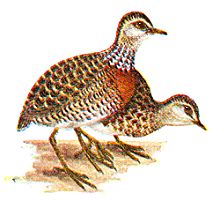- Plains Wanderer
Taxobox
name = Plains Wanderer
status = EN
status_system = iucn3.1
trend = down

regnum =Animal ia
phylum = Chordata
classis =Aves
ordo =Charadriformes
familia = Pedionomidae
familia_authority = Bonaparte, 1856
genus = "Pedionomus"
species = "P. torquatus"
binomial = "Pedionomus torquatus"
binomial_authority = Gould,1841 The Plains Wanderer, "Pedionomus torquatus", is a unique
bird and is put in a family of its own. It is endemic toAustralia .Description
This is a
quail -like ground bird, measuring 15–19 cm. The adult male is light brown above, with fawn-white underparts with black crescents. The adult female has a distinctive white-spotted black collar. They are poor flyers, preferring to run when startled. Females lay four eggs, which the male then incubatescite book |editor=Forshaw, Joseph|author= Archibald, George W.|year=1991|title=Encyclopaedia of Animals: Birds|publisher= Merehurst Press|location=London|pages= 101|isbn= 1-85391-186-0] .Taxonomy
It was formerly believed to be related to the
buttonquail s and thus placed in thegamebird orderGalliformes or with the cranes and rails inGruiformes .DNA-DNA hybridization andRAG-1 sequence data places it as awader related to thejacana s (Sibley & Ahlquist 1990, Paton "et al." 2003, Thomas "et al." 2004, van Tuinen "et al." 2004). It thus represents a remarkable case of morphological convergence.Conservation Status
Population decline has been caused by the conversion of native
grassland s to cultivation.International
This bird is listed as an
endangered species on the 2007 IUCN Red List.Australia
Plains Wanderers are listed as vulnerable on the Australian
Environment Protection and Biodiversity Conservation Act 1999 . Their conservation status also varies from state to state within Australia. For example:
* The Plains Wanderer is listed as threatened on the VictorianFlora and Fauna Guarantee Act (1988) . [ [http://www.dse.vic.gov.au/DSE/nrenpa.nsf/LinkView/EADA0F1874AF9CF24A2567C1001020A388BBA5581CF9D859CA256BB300271BDB Department of Sustainability and Environment - information on status] ] Under this Act, an "Action Statement" for the recovery and future management of this species has been prepared. [ [http://www.dse.vic.gov.au/DSE/nrenpa.nsf/LinkView/617768308BCB666E4A25684E00192281E7A24BB36FF60A144A256DEA00244294 Department of Sustainability and Environment - Action Statement] ]References
* Database entry includes a range map, a brief justification of why this species is endangered, and the criteria used
* Paton, T. A.; Baker, A. J.; Groth, J. G. & Barrowclough, G. F. (2003): RAG-1 sequences resolve phylogenetic relationships within charadriiform birds. "Molecular Phylogenetics and Evolution" 29: 268-278. doi|10.1016/S1055-7903(03)00098-8 (HTML abstract)
* Sibley, Charles Gald & Ahlquist, Jon Edward (1990): "Phylogeny and classification of birds". Yale University Press, New Haven, Conn.
* Thomas, Gavin H.; Wills, Matthew A. & Székely, Tamás (2004): A supertree approach to shorebird phylogeny. "BMC Evol. Biol." 4: 28. doi|10.1186/1471-2148-4-28 [http://www.pubmedcentral.org/picrender.fcgi?artid=515296&blobtype=pdf PDF fulltext] [http://www.pubmedcentral.org/articlerender.fcgi?artid=515296#supplementary-material-sec Supplementary Material]
* van Tuinen, Marcel; Waterhouse, David & Dyke, Gareth J. (2004): Avian molecular systematics on the rebound: a fresh look at modern shorebird phylogenetic relationships. "Journal of Avian Biology" 35(3): 191-194. [http://www.stanford.edu/group/hadlylab/images/Lab%20Members/Marcel/JAB2004.PDF_1.pdf PDF fulltext]External links
* [http://www.birdlife.org/datazone/search/species_search.html?action=SpcHTMDetails.asp&sid=2977&m=0 BirdLife Species Factsheet.]
Wikimedia Foundation. 2010.
